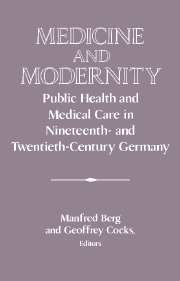Book contents
- Frontmatter
- Introduction
- 1 To Benefit the Poor and Advance Medical Science: Hospitals and Hospital Care in Germany, 1820-1870
- 2 From Traditional Individualism to Collective Professionalism: State, Patient, Compulsory Health Insurance, and the Panel Doctor Question in Germany, 1883—1931
- 3 In Search of German Social Darwinism: The History and Historiography of a Concept
- 4 Modern German Doctors: A Failure of Professionalization?
- 5 The Mentally Ill Patient Caught between the State's Demands and the Professional Interests of Psychiatrists
- 6 Rationalizing the Therapeutic Arsenal: German Neuropsychiatry in World War I
- 7 Sterilization and “Medical” Massacres in National Socialist Germany: Ethics, Politics, and the Law
- 8 The Old as New: The Nuremberg Doctors' Trial and Medicine in Modern Germany
- 9 The Debate that Will Not End: The Politics of Abortion in Germany from Weimar to National Socialism and the Postwar Period
- 10 The Sewering Scandal of 1993 and the German Medical Establishment
- Index
7 - Sterilization and “Medical” Massacres in National Socialist Germany: Ethics, Politics, and the Law
Published online by Cambridge University Press: 05 January 2013
- Frontmatter
- Introduction
- 1 To Benefit the Poor and Advance Medical Science: Hospitals and Hospital Care in Germany, 1820-1870
- 2 From Traditional Individualism to Collective Professionalism: State, Patient, Compulsory Health Insurance, and the Panel Doctor Question in Germany, 1883—1931
- 3 In Search of German Social Darwinism: The History and Historiography of a Concept
- 4 Modern German Doctors: A Failure of Professionalization?
- 5 The Mentally Ill Patient Caught between the State's Demands and the Professional Interests of Psychiatrists
- 6 Rationalizing the Therapeutic Arsenal: German Neuropsychiatry in World War I
- 7 Sterilization and “Medical” Massacres in National Socialist Germany: Ethics, Politics, and the Law
- 8 The Old as New: The Nuremberg Doctors' Trial and Medicine in Modern Germany
- 9 The Debate that Will Not End: The Politics of Abortion in Germany from Weimar to National Socialism and the Postwar Period
- 10 The Sewering Scandal of 1993 and the German Medical Establishment
- Index
Summary
The place in the history of medicine in Germany of Nazi sterilization policy and the massacres in which medicine and medical doctors were involved, especially the politics of “euthanasia,” is by no means self-evident. Sterilization is a form of birth control that may be contested but is today usually considered legitimate; the concept of euthanasia has oscillated, from the late nineteenth century, between voluntary and nonvoluntary death, between one's own and someone else's control over one's death. The question therefore is that of birth control and death control, of the agents, circumstances, and purposes of such control. Birth and death are multifaceted issues, and many of their aspects are dealt with by medical theory, practice, and the medical profession, particularly in the nineteenth and twentieth centuries. It was (and is) the task of medical theory and practice to help new creatures come into the world and help them and the other human beings to live and survive by curing and healing. But it is not this task that defines the place of sterilization and euthanasia in the history of medicine from 1933 to 1945 but the fact that medical theory and practice largely took an opposite turn. Medicine and many doctors came to be involved in the National Socialist crimes. Furthermore, they were among the most important agents of these crimes, precisely because procreation and death came to be objects of National Socialist policy, of race hygiene, eugenics, or, to use the specifically Nazi term, Erb- und Rassenpflege (genetic and racial hygiene).
- Type
- Chapter
- Information
- Medicine and ModernityPublic Health and Medical Care in Nineteenth- and Twentieth-Century Germany, pp. 149 - 172Publisher: Cambridge University PressPrint publication year: 1997
- 4
- Cited by



